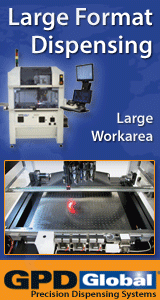Printed Circuit Board Assembly & PCB Design Forum
SMT electronics assembly manufacturing forum.
- SMTnet
- »
- Electronics Forum
- »
- Internal Oven Calibration
Internal Oven Calibration
Views: 5805
![]() I am putting together an internal oven calibration procedure...
- Feb 10, 2006
by
RFredericks
I am putting together an internal oven calibration procedure...
- Feb 10, 2006
by
RFredericks
![]()
![]()
![]() Russ,
We use a unit called a Datapaq surveyor to monitor ou...
- Feb 10, 2006
by
Sr. Tech
Russ,
We use a unit called a Datapaq surveyor to monitor ou...
- Feb 10, 2006
by
Sr. Tech
![]()
![]()
![]() We do the same as SR Tech but add in a check of the thermoco...
- Feb 10, 2006
by
jdengler
We do the same as SR Tech but add in a check of the thermoco...
- Feb 10, 2006
by
jdengler
![]()
![]()
![]() We do something quite simple that may or may not be adequate...
- Feb 10, 2006
by
RDR
We do something quite simple that may or may not be adequate...
- Feb 10, 2006
by
RDR
![]()
![]()
![]() Establish a profile board. It should be representative of w...
- Feb 10, 2006
by
Establish a profile board. It should be representative of w...
- Feb 10, 2006
by
![]()
![]() One factor everyone overlooks is that furnace and external T...
- Feb 11, 2006
by
One factor everyone overlooks is that furnace and external T...
- Feb 11, 2006
by
![]()
![]() Hi,
Does it really matter what temp the oven runs at as l...
- Feb 13, 2006
by
Grant
Hi,
Does it really matter what temp the oven runs at as l...
- Feb 13, 2006
by
Grant
![]()
![]()
![]() That's why I parallel ported the T/C's. Now I can use a cal...
- Feb 13, 2006
by
That's why I parallel ported the T/C's. Now I can use a cal...
- Feb 13, 2006
by
![]()
![]() Hi Grant,
Most inspectors want your oven temps close to ...
- Feb 13, 2006
by
Hi Grant,
Most inspectors want your oven temps close to ...
- Feb 13, 2006
by
![]()
![]() I believe I understand what Ken is talking about. Most "cal...
- Feb 13, 2006
by
Stephen
I believe I understand what Ken is talking about. Most "cal...
- Feb 13, 2006
by
Stephen
![]()
![]()
![]() Thanks everyone,
I have found your postings very helpf...
- Feb 13, 2006
by
RFredericks
Thanks everyone,
I have found your postings very helpf...
- Feb 13, 2006
by
RFredericks
![]()
![]()
![]() I have been through this before. At a med. device company th...
- Feb 13, 2006
by
Steve Thomas
I have been through this before. At a med. device company th...
- Feb 13, 2006
by
Steve Thomas
![]()
![]()
![]() Same way. Either plug into existing T/C or use a hand held ...
- Feb 13, 2006
by
Same way. Either plug into existing T/C or use a hand held ...
- Feb 13, 2006
by
![]()
![]() ECD's OvenRIDER is the only instrument I know that can measu...
- Feb 13, 2006
by
PeteC
ECD's OvenRIDER is the only instrument I know that can measu...
- Feb 13, 2006
by
PeteC
![]()
![]()
![]() Ah yes, environmental chamber. Jargon updated, thanks!
...
- Feb 13, 2006
by
RFredericks
Ah yes, environmental chamber. Jargon updated, thanks!
...
- Feb 13, 2006
by
RFredericks
![]()
![]()
![]() You are correct. Regardless of what any auditor is asking w...
- Feb 13, 2006
by
You are correct. Regardless of what any auditor is asking w...
- Feb 13, 2006
by
![]()
![]() Samir,
I didn't get the e-mail unless I thought it was spam...
- Feb 20, 2006
by
PeteC
Samir,
I didn't get the e-mail unless I thought it was spam...
- Feb 20, 2006
by
PeteC
![]()
![]()
![]() I agree with Steve and would hate to have Ken audit me.
"...
- Feb 22, 2006
by
I agree with Steve and would hate to have Ken audit me.
"...
- Feb 22, 2006
by
- SMTnet
- »
- Electronics Forum
- »
- Internal Oven Calibration







